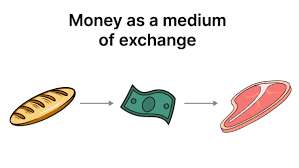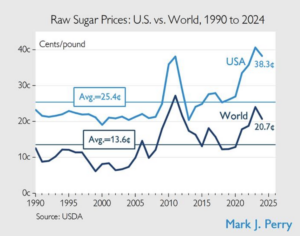Every free trader has heard it: Sure, we’d all love for there to be free trade, sounds nice in theory, but in the real world it can’t happen. Supposedly free trade is a utopian position, and protectionism is the pragmatic, realistic alternative.
This common framing of the issue of international trade is exactly backward. Protectionism is a utopian theory based on the assumptions that individuals and businesses will act contrary to their self-interest, government will act in the national interest, and special interests will stay on the sidelines. Free trade is how you live your everyday life.
In The Wealth of Nations, Adam Smith endeavored to show how people acting in their self-interest could benefit others. The mechanism by which that happens is the division of labor. When people specialize in what they do best and trade for the rest, they make themselves and the people they trade with richer than they would otherwise be.
This insight lies at the heart of economics. It is not obvious in the abstract, but experience has shown it to be true. Countries where people don’t specialize and trade — countries where people grow their own food, make their own clothes, build their own houses — are the world’s poorest. The country that elevated self-sufficiency to a foundational national principle and has almost completely isolated itself from international trade — North Korea, with its Juche deology — is a communist police state.
North Korea has to be repressive to prevent trade, because trade is natural to human beings. “In almost every other race of animals each individual, when it is grown up to maturity, is entirely independent, and in its natural state has occasion for the assistance of no other living creature,” Smith wrote in The Wealth of Nations. He imagines the absurdity of dogs deliberating over trade in bones.
“But man has almost constant occasion for the help of his brethren, and it is in vain for him to expect it from their benevolence only,” Smith wrote. “He will be more likely to prevail if he can interest their self-love in his favour, and shew them that it is for their own advantage to do for him what he requires of them.”
This is the first area where protectionism’s utopianism shows. Protectionism says that the natural human regard for self-interest that undergirds trade is actually a disease in need of treatment. It posits that people need to act contrary to human nature to really thrive and that therefore their desires and preferences must be reformed.
The agent of that reformation is the government. Protectionists must hold a very idealistic view of government and must place an extraordinary amount of trust in government to execute their plans. If the government is not as competent or as beneficent as they believe, their plans won’t work.
…..
If the protectionist argument is right, why is it right only for countries? Many U.S. states are larger than many countries, so it’s not a geographic or population issue. It’s not as though there isn’t significant variation in wealth between states: Massachusetts has roughly double the GDP per capita of Mississippi and an average hourly wage over $14 higher.
If anything, the case for protectionism between the states should be stronger than between countries because it’s much easier to move production to another place under the same laws where the people speak the same language and have access to many of the same public goods than it is to train new workers on a different continent. The manufacturing center of the U.S. has in fact moved: historically, from the Northeast to the Midwest, and now, from the Midwest to the South.
If the Constitution didn’t prohibit it, should Massachusetts have tariffs to protect its workers from Mississippians? Maybe some protectionists would be consistent, but it’s doubtful. When the level of analysis is changed from international to interstate — or, even more absurdly, intercity — it’s clear that free trade is superior, even though it will also result in job losses for some people as production moves from place to place.
Trump gives away the game on this when he talks about how tariffs would disappear if Canada became a state. He’s right, they would, but that would mean that the same people would be buying and selling the same stuff, so the basic economic picture wouldn’t change at all. The biggest difference would be that around 30 million Canadians would be voting in U.S. elections, swinging our politics sharply leftward. It seems better to have the economic gains without the political consequences by having a free trade deal with Canada, which is exactly what the U.S. has done, starting under Reagan in 1988.
One bad policy decision inevitably leads to another to compensate for the damage, and that’s already true of President Trump’s new 25% tariffs on auto imports. The Journal’s news pages reported late Thursday that Mr. Trump threatened auto executives on a call this month not to raise prices if he went ahead with his tariffs.
At least he recognizes in private that his tariffs aren’t cost-free for business or consumers, which wasn’t previously clear. But like his Democratic predecessors, he apparently thinks he can browbeat CEOs to cover up for them.
…..
During last year’s campaign, Kamala Harris proposed letting the Federal Trade Commission dun food companies that raise prices too much. Mr. Trump responded by noting that “after causing catastrophic inflation, Comrade Kamala announced that she wants to institute socialist price controls.”
Well, now Mr. Trump seems to be imitating Comrade Kamala to prevent catastrophic price increases from his auto tariffs. It’s hard to predict the magnitude of the price impact, though Ford Motor CEO Jim Farley warned last month that “long term, a 25% tariff across the Mexico and Canada borders would blow a hole in the US industry that we’ve never seen.”
…..
Businesses were optimistic when Mr. Trump returned to the Oval Office because they thought he understood how markets work. They may have been mistaken.
It’s not just Trump’s rhetoric that has the energy industry on edge; it’s his trade policies, too. One respondent noted that tariffs “immediately increased the cost of our casing and tubing by 25 percent.” Another said, “Washington’s tariff policy is injecting uncertainty into the supply chain.”
GMU Econ alum Mark Perry makes a good point on his Facebook page:
Reversing a 75-year trend of lower tariff rates, Team Trump’s tariffs are expected to take tariff rates to 8.4% this year, the highest since 1948.
Reminder: There is NO example in the history of advanced economies when sweeping tariffs had the positive effects the protectionist Trump team believes are waiting for us on the other side of this tariff push and trade war. Not. One.
Phil Magness makes a good point on his Facebook page:
Trump’s decision to suspend US contributions to the WTO undercuts his oft-stated complaint that European powers are not meeting their contribution obligations to NATO.
I got to thinking a lot about what a weird bunch we libertarians are. On one hand, we are radicals — we oppose a great many government programs and actions that most people support. At the same time, we also have a principled attachment to process and the rule of law. And, in addition, we recognize that who does what matters enormously. The ends don’t justify the means, and all that. In other words, we want to achieve radical ends but in very disciplined — shall we say, nonradical — ways.
Johan Norberg writes about “the Swedish origins of ‘liberal’ as a political label.” A slice:
Most interestingly for our purposes, this revolution was initiated by the individual who was probably the first Swede to describe his philosophy as liberal. In a speech for the Royal Academy of the Sciences on July 25, 1804, on free markets and economic development, Georg Adlersparre described his ideas as “liberal” again and again. He wrote about “a higher and more liberal economic maxim” in contrast to monopolies and tariffs, described economic openness as the result of “refined and liberal economic principles” and argued that wealth is created by “a lively liberal and active economic spirit” of hard work and freedom of enterprise.
My Mercatus Center colleague Jack Salmon unpacks “the real sources of America’s fiscal imbalance.”


 Money performs a function of real value. It is not merely a veil. Persons will voluntarily exchange real goods and services for money units, even if they have no intrinsic worth and cannot be directly consumed or utilised. Money is valued for its instrumental usage in facilitating future exchanges.
Money performs a function of real value. It is not merely a veil. Persons will voluntarily exchange real goods and services for money units, even if they have no intrinsic worth and cannot be directly consumed or utilised. Money is valued for its instrumental usage in facilitating future exchanges.
 Trade skeptics overlook the dispersed benefits. Some find virtue in paying more for “fair trade” coffee, goods “made in America,” and local produce, but as twentieth-century economic journalist
Trade skeptics overlook the dispersed benefits. Some find virtue in paying more for “fair trade” coffee, goods “made in America,” and local produce, but as twentieth-century economic journalist  Contrary to what you might have heard, however, there’s no “Chinese model” to be seen as an intriguing if authoritarian alternative to Western economic liberalism. The Communist Party of China would like you to believe there is. Nope. After 1978 the Party merely started to permit an economic liberalism of the sort partially implemented in the West in the nineteenth century – though of course the Party did not permit anything like a corresponding liberalism in politics. The “Chinese [economic] model” is merely “the capitalist road.”
Contrary to what you might have heard, however, there’s no “Chinese model” to be seen as an intriguing if authoritarian alternative to Western economic liberalism. The Communist Party of China would like you to believe there is. Nope. After 1978 the Party merely started to permit an economic liberalism of the sort partially implemented in the West in the nineteenth century – though of course the Party did not permit anything like a corresponding liberalism in politics. The “Chinese [economic] model” is merely “the capitalist road.”
